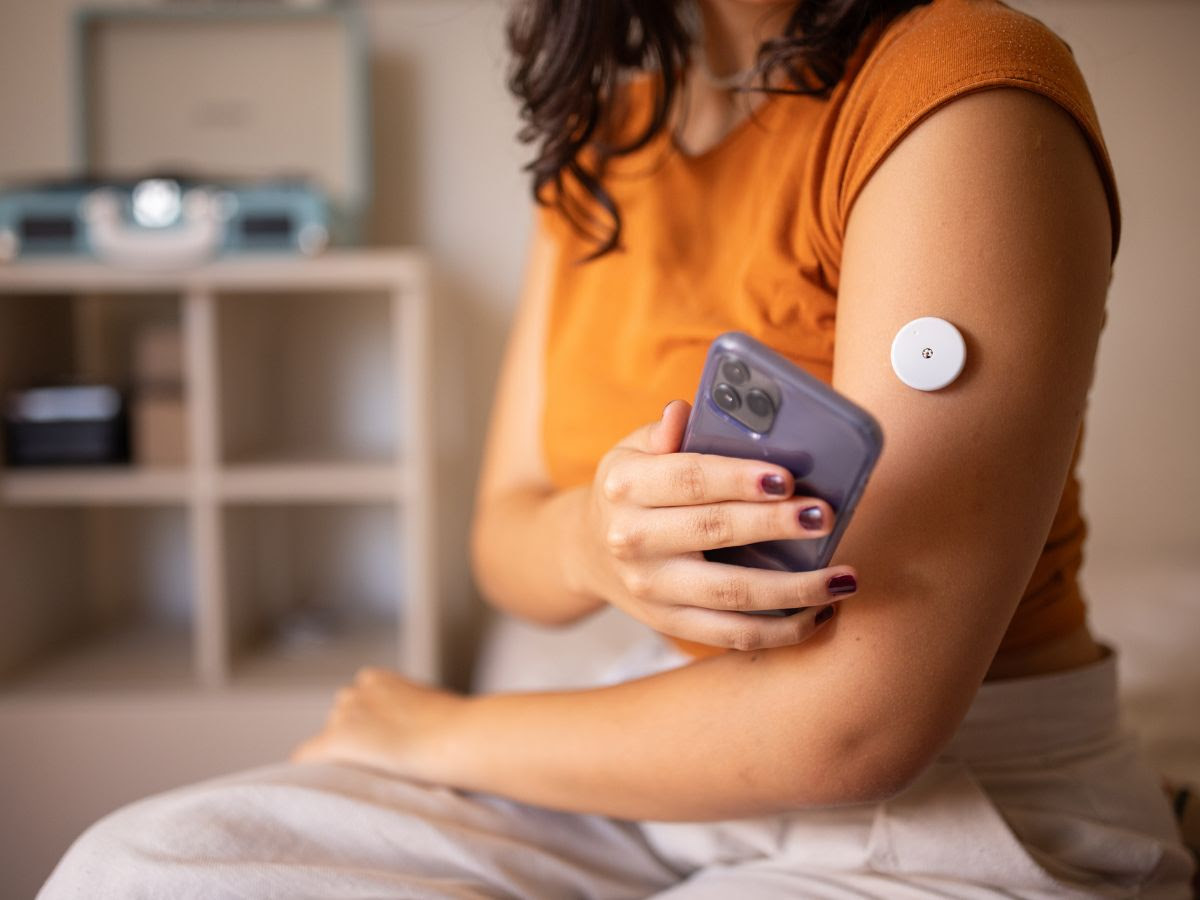Is CGM Right for Everyone?
By April Hopcroft
 While continuous glucose monitors are part of routine care for people with type 1 diabetes, there are many other people who may also benefit from real-time insight into glucose levels. Experts discussed how the device helps reduce low blood glucose, improve glycemic control, and support lifestyle change.
While continuous glucose monitors are part of routine care for people with type 1 diabetes, there are many other people who may also benefit from real-time insight into glucose levels. Experts discussed how the device helps reduce low blood glucose, improve glycemic control, and support lifestyle change.
Diabetes care has seen tremendous innovation in the past decades, from the development of medications for weight loss to the creation of tubeless insulin pumps. Yet perhaps one of the most significant areas of progress has been in glucose monitoring.
People who have lived with diabetes for more than 50 years often describe the so-called “dark ages” of diabetes, before modern technology for glucose monitoring existed. Urine testing was initially the only way to measure blood sugar, and it wasn’t available outside of a laboratory until the mid-1940s. Fingersticks and test strips replaced urine testing in the 1980s, and the first ever continuous glucose monitor (CGM) was approved in 1999.
Today, people with diabetes can see their glucose levels from a small sensor on the body. There are several different options available, such as the Dexcom G7, FreeStyle Libre 2 and 3, and Guardian 4, as well as the Eversense E3 implantable sensor.
Not only has the advent of CGM transformed blood glucose monitoring, it has also enabled other inventions like automated insulin delivery (AID). “CGM has revolutionized the way we do things,” said Dr. Irl Hirsch, Professor of Medicine at the University of Washington.
How is CGM useful?
Broadly, CGM helps manage blood glucose, reduce hypoglycemia, and improve overall glycemic control – all while reducing the need for regular fingersticks. Using CGM has also been shown to reduce hospitalizations and improve mood and quality of life.
“CGM is all about the speed and direction of change for people with diabetes,” said Natalie Bellini, DNP, an endocrine nurse practitioner and Program Director of Diabetes Technology at University Hospitals in Cleveland, Ohio.
With trend arrows that indicate whether your blood sugar is rising, falling, or steady, you can adjust your behavior to prevent spikes or lows. For instance, treating a blood sugar level of 68 mg/dL that is slowly rising would look very different from addressing a value of 68 mg/dL that is falling rapidly.
Bellini added that CGM helps to optimize patients’ medications. “I can match the glucose trend with the right medication, and use the downloads to explain treatment options to a person with diabetes sitting next to me,” she said.
Beyond medication, CGM opens up discussions about how lifestyle changes can help address high and low glucose levels. Dr. Richard Pratley, a diabetes expert and physician at AdventHealth in Orlando, Florida, compared CGM to the gas mileage indicator in a car. When you have the data in front of you, you’re more likely to change your behavior. By providing immediate feedback, CGM reinforces healthy choices.
For diet
Once people understand what CGM trend arrows mean, they can modify their behavior accordingly. For instance, if your glucose is rising just before a meal, you might decide to take more insulin, eat fewer refined carbs, or take a walk after eating to prevent a post-meal spike.
Overall, Bellini said spreading out carbohydrate consumption is one of the biggest challenges for people with diabetes. Using CGM helps people recognize that they may not be able to eat 50 grams of carbs at once without spiking their blood sugar. However, it may be possible to eat smaller portions of carbs at multiple meals and snacks, with minimal increase in blood glucose.
For exercise
 Even with the most sophisticated diabetes technology, it can be hard to prevent hypoglycemia (low blood sugar) during physical activity. Depending on the type of exercise, some people even experience hyperglycemia (high blood sugar) while being active, which can also be dangerous if left untreated.
Even with the most sophisticated diabetes technology, it can be hard to prevent hypoglycemia (low blood sugar) during physical activity. Depending on the type of exercise, some people even experience hyperglycemia (high blood sugar) while being active, which can also be dangerous if left untreated.
Using a CGM can help prevent low blood sugar during and after exercise, since you can monitor trends and be alerted before experiencing severe lows or highs. In addition to wearing a CGM, making a game plan to adjust insulin accordingly and performing a cool down can go a long way towards preventing exercise-induced hypos.
What are the benefits of CGM for time in range and A1C?
One of the major advantages of CGM is the ability to understand your time in range. The constant stream of data points from the sensor allows you to see how many hours of the day you spend in your target glucose range – for most people, this range is 70 to 180 mg/dL.
While A1C provides an estimate of average blood sugar, using a CGM allows you to see the highs, lows, and in-range values that are part of daily life with diabetes.
Just wearing a CGM – without any additional changes in medication or lifestyle – can lead to improvements in glycemic control. In the WISDM study investigating CGM use in older adults with type 1 diabetes, simply having access to a CGM led to improvements in time in range, A1C, and hypoglycemia.
Likewise, a study found that people with type 2 diabetes who started using CGM saw a 1% reduction in A1C after 3 months. This improvement in A1C happened without any adjustments to medications, suggesting that one of the benefits of CGM lies in its ability to support lifestyle modification, including changes to the diet as well as increased physical activity. This level of reduction is similar to that seen with some glucose-lowering medications like SGLT-2 inhibitors and DPP-4 inhibitors.
Who can benefit from CGM?
“I think everyone with diabetes deserves to wear a CGM,” Bellini said. That said, both Bellini and Pratley emphasized that CGM may not be right for everyone. Some people may not want access to that much information at once, while others may prefer not to wear a device on their body.
Those who find it difficult to obtain CGM due to cost, lack of a prescription, or lack of insurance coverage may also consider requesting a professional CGM. This means a healthcare provider gives a patient CGM for a short period of time (usually 2 weeks) to help them better understand their glucose levels.
If you have type 1 diabetes
CGM is part of routine care for people with type 1 diabetes. Using CGM helps keep people safe from dangerously low blood sugars, while also improving overall glycemic control and quality of life.
 Pratley highlighted the value of CGM for children with type 1 diabetes and their caregivers, especially when combined with AID systems. Before the invention of CGM, parents had no way of knowing if their child might experience low blood sugar in the middle of the night. By providing predictive alerts and alarms when blood sugar starts to drop, CGM reduces the fear of hypoglycemia and can help children and their caregivers get high-quality sleep, and research shows that use of AID reduces nocturnal hypoglycemia and improves sleep.
Pratley highlighted the value of CGM for children with type 1 diabetes and their caregivers, especially when combined with AID systems. Before the invention of CGM, parents had no way of knowing if their child might experience low blood sugar in the middle of the night. By providing predictive alerts and alarms when blood sugar starts to drop, CGM reduces the fear of hypoglycemia and can help children and their caregivers get high-quality sleep, and research shows that use of AID reduces nocturnal hypoglycemia and improves sleep.
Perhaps the most telling comes from Hirsch’s older patients, many of whom have lived with diabetes for several decades. “They all say, ‘If it wasn’t for CGM, I wouldn’t be alive,’” Hirsch said.
Indeed, many elderly people with diabetes who use insulin may not feel their hypoglycemia, especially those who take other medications like beta blockers. It’s important to recognize that glucose targets differ by age, and the number one goal for older people with diabetes is to eliminate low blood sugar in order to prevent falls. When talking with older adults about CGM, Bellini emphasized that using the technology offers greater independence and may enable them to live on their own for longer.
If you have type 2 diabetes
While CGM isn’t used universally in type 2 diabetes, the data are clear: for people taking insulin, using CGM leads to significant decreases in A1C and a reduction in hypoglycemia rates.
“For many with prediabetes or newly diagnosed type 2 diabetes, CGM can be as important as any medication as it helps people better understand exactly what changes their blood glucose levels,” Hirsch said.
In type 2 diabetes, Hirsch views CGM as a tool to inform future decisions. “The question isn’t what you do in the moment,” he said. “It’s how you prevent a low or high blood sugar from happening next time – what type of food or exercise strategies can you use?” Hirsch noted that education is crucial, and some people may need additional support to interpret CGM tracings and understand what lifestyle changes to make.
Until recently, many insurance companies didn’t cover CGMs for people with type 2 diabetes. In March 2023, Medicare began covering CGMs for people with type 2 diabetes on insulin as well as those who are not on insulin but have a history of hypoglycemia. In June 2023, UnitedHealthcare – the biggest health insurance company in the US – announced that it would cover CGM for all adults with type 2 diabetes who are on insulin.
Currently, the FreeStyle Libre 2 and 3 CGMs can be used by people with type 2 diabetes not on insulin or those with prediabetes. Looking ahead, Dexcom Stelo is expected to launch later this year for people with type 2 diabetes who don’t use insulin.
If you are pregnant and have diabetes
Guidelines recommend using CGM for pregnancies complicated by type 1 diabetes, and studies have suggested that CGM may also be helpful for pregnant people with type 2 or gestational diabetes.
 “Everyone who is pregnant, with any kind of diabetes, should be on CGM,” Bellini said. Since glucose targets are especially strict in pregnancy, Pratley said CGM can be very helpful in helping people attain these goals and reducing the burden of diabetes management.
“Everyone who is pregnant, with any kind of diabetes, should be on CGM,” Bellini said. Since glucose targets are especially strict in pregnancy, Pratley said CGM can be very helpful in helping people attain these goals and reducing the burden of diabetes management.
Since insulin needs change dramatically throughout pregnancy, using CGM can help you determine when to increase your dose by examining glucose trends and patterns. Research shows that using CGM in pregnancy improves the health of babies through better management of maternal glucose levels.
The Dexcom G7 and the FreeStyle Libre 2 and 3 are approved for use in pregnancy.
If you have prediabetes or a family history of diabetes
According to Bellini, people with prediabetes are ideal candidates for CGM, since they often experience unpredictable high blood sugar levels specifically after large meals. In addition to helping people identify patterns and make changes to their diet and lifestyle, CGM can reveal undiagnosed diabetes and could lead to earlier use of diabetes medication.
However, it’s important to be aware of false lows if you have prediabetes. “With the right education and counseling, people with prediabetes do well on CGM, provided alarms are turned off or set appropriately,” Bellini said.
If you don’t have diabetes and are curious to gain more insight into your health
In recent years, there has been growing investment into developing CGM for people who are not concerned with diabetes. For instance, the company Supersapiens sells a CGM targeted at cyclists, runners, and other elite performance athletes, with no prescription required. Other companies, such as Nutrisense and Signos, market sensors toward people without diabetes who are seeking to lose weight or want to gain a better understanding of how their diet affects glucose.
Reasons CGM may not be right for everyone
While CGM provides an enormous amount of valuable data, it can also lead to a sense of “information overload.” For people with less advanced diabetes, especially those who don’t take insulin or other medications that can cause hypoglycemia, alarm fatigue can be a very real concern. Depending on your diabetes, you might consider turning off alarms to optimize CGM for your own needs.
Because CGMs automatically update readings every few minutes, critics of widespread CGM use point out that constant real-time data could also worsen or trigger new disordered eating behaviors. Some mental health professionals have expressed concern about moral judgment being assigned to certain foods, such as a banana being considered “bad” because it spikes blood sugar.
Lastly, CGM is not always accurate – certain medications and supplements can interfere with its ability to measure glucose levels.
It’s important to discuss these considerations with your healthcare provider before deciding whether to use CGM.
The bottom line
CGM provides many benefits for people with diabetes: preventing hypoglycemia, reducing A1C, and improving time in range. Newer research has shown that CGM is useful for many people across the spectrum of diabetes, not just those with type 1.
Better overall glycemic control can improve quality of life and may also translate into a reduced risk of diabetes complications. “With the increased use of sensors (and soon ketone sensors) and insulin pumps, we hopefully will see dramatic reductions in both diabetic ketoacidosis (DKA) and severe hypoglycemia,” Hirsch said.
Pratley also expressed excitement about dual continuous ketone and glucose monitors and is looking forward to seeing more data on the use of CGM in people at risk of diabetes, such as those who have had pancreatitis.
Looking to the future, Bellini envisions a world where CGM and other diabetes technology greatly simplifies daily management for people with diabetes. “Incorporating CGM into AID is the ‘tip of the iceberg,’” she said. “My ultimate wish is that the CGM talks to the AID, AID gets smarter, insulin absorption becomes faster and more predictable, and people with diabetes should never have to bolus again.”
Learn more about CGM and diabetes technology:







